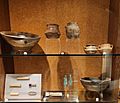Bell Beaker culture facts for kids
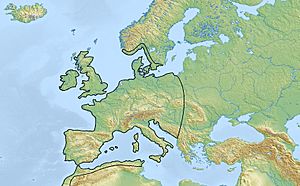
Where the Bell Beaker culture was found
|
|
| Geographical range | Europe and Northwest Africa |
|---|---|
| Period | Copper Age – Early Bronze Age |
| Dates | c. 2800–1800 BC |
| Major sites | Castro of Zambujal, Portugal |
| Preceded by | Corded Ware culture, Funnelbeaker culture, Neolithic British Isles, Neolithic France, Chalcolithic Iberia, Chalcolithic Italy, Baden culture, Vučedol culture, Horgen culture |
| Followed by | Únětice culture, Bronze Age Britain, Armorican Tumulus culture, Rhône culture, Nordic Bronze Age, Argaric culture, Bronze Age Iberia, Polada culture, Nuragic culture, Cetina culture, Middle Helladic Greece, Bronze Age Ireland, Hilversum culture, Elp culture, Mierzanowice culture |
The Bell Beaker culture is named after its special bell-shaped drinking cups. This culture appeared around 2800 BC, at the start of the European Bronze Age. It lasted in Britain until about 1800 BC. In other parts of Europe, it ended around 2300 BC. The Bell Beaker culture spread widely across Western Europe. You can find its traces in Spain and Portugal, stretching to the Danube river. It also reached Great Britain and Ireland, as well as Sardinia and Sicily. Some small coastal areas in north-western Africa also show its influence.
This culture had many regional differences. A study from 2018 showed that people from this culture were genetically diverse. The Bell Beaker culture existed at the same time as the Corded Ware culture. It also followed the Funnelbeaker culture in northern Europe. The name "Glockenbecher" was first used in 1900 by Paul Reinecke. The English name "Bell Beaker" came from John Abercromby in 1904.
In its early days, the Bell Beaker culture was like a western cousin to the Corded Ware culture. Around 2400 BC, Bell Beaker people moved eastward. They spread into areas where the Corded Ware culture lived. This time saw a lot of cultural mixing in Western Europe. Before this, Europe had been quite isolated during the Stone Age.
Later, the Bell Beaker culture became more than just a style of pottery. It involved working with copper and gold. People used long-distance trade routes. They were skilled in archery. They also shared similar ideas about religion and society. Some people became more important or powerful. Even with these shared ideas, local differences remained. These included burial styles, housing, and local pottery. Despite this, some experts believe it became a widespread "Bell Beaker civilization."
Contents
How the Bell Beaker Culture Started and Spread
Where It Began
The first Bell Beaker items were not found in one continuous area. Instead, they appeared in small groups across Europe. Their presence wasn't always linked to a specific type of building or burial custom. However, over time, the Bell Beaker culture became more unified.
The earliest "maritime" Bell Beaker designs date back to about 2800 BC. These were found near the Tagus river in Portugal. Some think these designs were inspired by smaller, older "Copoz" cups. These cups had impressed decorations and were common around the Tagus. Some researchers suggest the Maritime style came from North Africa. This happened through sea travel between Spain and Morocco.
More recent studies describe the Bell Beaker culture as a mix of ideas. It was a style that connected different regions. These regions had their own unique traditions.
How It Expanded and Met Other Cultures
The first movements from the Tagus area were by sea. People traveled south to the Mediterranean Sea. They set up small communities in southern Spain and France. They also went into the Po Valley in Italy. This likely happened along old trade routes used for jadeite axes. A northern route took them to the coast of Armorica.
A community in southern Brittany was connected to river routes. These routes went along the Loire and Seine rivers to the lower Rhine. This was a well-known trade path. Maritime Bell Beakers first reached the Lower Rhine around 2600 BC.
Another expansion brought Bell Beakers to Hungary by 2500 BC. In this area, they met groups like the Vučedol culture. These groups had been influenced by the Yamnaya culture. While early Bell Beaker people liked daggers and bows, the Carpathian Basin favored shaft-hole axes. Here, Bell Beaker people adopted local pottery styles. These new pottery types then spread with the classic bell beakers.
The Rhine river was near the western edge of the large Corded Ware zone. This created a meeting point with the Bell Beaker culture. From there, the Bell Beaker culture spread further east. It replaced the Corded Ware culture as far as Vistula (Poland).
In 2014, a study showed that single burials were common across the Bell Beaker area. People also used communal burials and reused older burial sites. This changed the old idea that single burials only came from the Corded Ware culture.
The earliest copper production in Ireland started around 2400–2200 BC. This was linked to early Beaker pottery. Local ores were melted to make the first copper axes in Britain and Ireland. Similar methods were used in the Tagus region and parts of France. This suggests that the early spread of Maritime Bell Beakers was connected to finding copper. They also looked for other rare materials.
How Ideas and People Spread
For a long time, experts debated how the Bell Beaker culture spread. Was it because people moved to new places? Or was it because ideas and objects were shared?
People Moving
The Bell Beaker pottery looked very different and appeared suddenly. This made many believe that a group of people migrated across Europe. They brought their special "Bell Beaker package" of items with them.
Some thought these were "missionaries" from Spain. They spread knowledge of copper metalwork. Others believed they were mobile groups of traders or craftspeople. These groups might have settled among local Stone Age cultures.
The way Bell Beaker people buried their dead was new to Western Europe. They often buried individuals under mounds with weapons. This was different from earlier collective burials without weapons. This style was more like the Corded Ware traditions.
Ideas Spreading
Later, some experts thought the Bell Beaker culture was a 'package' of knowledge. This included religious beliefs and ways of working with copper, bronze, and gold. Local people adopted these ideas and objects. This new knowledge could have spread through trade or cultural contact.
For example, it might have been part of a special tradition about making and drinking a type of grain drink. Studies of pollen show more barley was grown, which could be for brewing. Bell Beaker items were often found near trade routes. This led to the idea that Bell Beaker people were originally bronze traders. They then settled and mixed with local groups. Early bronze tools suggest copper came from Spain first. Later, it came from Central Europe.
New Evidence for Migration
Recent studies in the Mediterranean and France have brought back the idea of migration. Looking at over 300 sites, experts found that human groups actually moved. They explored, made contact, settled, and mixed with local cultures. The movement patterns were complex. They went along the Atlantic and Mediterranean coasts, and sometimes far inland.
Genetic studies also support the migration idea. A 1998 study of graves in Germany found that many people came from far away. This was true for both children and adults. This suggests a big wave of migration.
More recent DNA studies from the 2010s have helped solve this debate. A 2017 study found little genetic link between early Bell Beaker people in Spain and Central Europe. This suggests early spread was not mainly by migration. However, the later spread of the Bell Beaker culture was strongly linked to migration. This is especially true for Britain. The Bell Beaker culture brought a lot of new genes from the Steppe region. This changed the local gene pool almost completely within a few centuries. About 90% of the original Stone Age genes were replaced.
Bell Beaker Objects
|
|
There are two main international Bell Beaker styles. The All Over Ornamented (AOO) style had patterns all over. A part of this was the All Over Corded (AOC) style, with cord patterns. The Maritime type had bands filled with comb or cord impressions. Later, other regional styles developed.
The beakers might have been used for special drinks. Some examples show traces of grain drinks. However, not all beakers were for drinking. Some were used to melt copper ores. Others held food or were used as burial urns. They were also used by important people to show their status.
Possible Language Connections
The Bell Beaker culture left no written records. So, we can only guess what languages they spoke. Some think it might be an early Indo-European culture. Others suggest it could be linked to an ancient language group called "Vasconic."
James Mallory (2013) noted that the Bell Beaker culture was linked to a group of Indo-European languages. These included early forms of Celtic, Italic, Germanic, and Balto-Slavic languages.
Physical Appearance
Early studies of Bell Beaker skeletons found that these people looked different. They were described as tall, with strong bones and rounder heads. This suggested they had moved from other areas. This idea fit with discoveries of new farming methods and metalworking skills. However, later studies questioned this. They suggested differences could be due to environment. But more recent evidence still points to migration.
A study of teeth from Bell Beaker skeletons found differences in most areas. This suggests new people arrived. Only in Northern Spain and the Czech Republic were there clear links to earlier populations.
Genetics
DNA studies in the 2010s helped answer how the culture spread. They found that Bell Beaker people in Germany and the Czech Republic had a lot of "Steppe-related ancestry." This means their genes came from groups like the Corded Ware and Yamnaya cultures. The Y-chromosome (passed from father to son) of Bell Beaker males was mostly R1b-M269. This gene group is linked to Steppe migrants arriving in Europe.
Studies also found that Bell Beaker people were closely related to the Corded Ware culture. They were also related to the Unetice culture and the Nordic Bronze Age.

A 2018 study in Nature confirmed a big change in Western Europe's population. In Britain, the Bell Beaker culture brought many Steppe-related genes. This led to about 90% of the local gene pool being replaced. British Bell Beaker people were genetically similar to those in Central Europe. Both men and women with Steppe ancestry took part in this change. The R1b Y-chromosome, absent before, became very common. Bell Beaker arrivals also had genes for lighter skin and eye color.
In Spain, early Bell Beaker samples had no Steppe ancestry. But between 2500 and 2000 BC, 40% of Spain's ancestry changed. Nearly 100% of Y-chromosomes were replaced by Steppe ancestry. The main source for this was likely Bell Beaker people from Germany. More men than women contributed to this genetic change.
Other studies confirmed that R1b genes arrived in Switzerland and France during the Bell Beaker period. Early Bell Beaker people in the Czech Republic had similar genes to Corded Ware people. The R1b-L151 gene was common in early Corded Ware males. This gene is an ancestor to R1b-P312, common in Bell Beaker males.
Bronze Age people in Italy had a mix of older local genes and Steppe-related genes. This suggests Steppe ancestry came from Bell Beaker groups in Central Europe. R1b-L11, common in Bell Beaker burials, was found in Italian Bronze Age males.
A 2020 review found European Bronze Age ancestry in the Guanches of the Canary Islands. This could be due to Bell Beaker pottery found in North Africa.
Where the Bell Beaker Culture Was Found
Bell Beaker people used sea and river travel. This helped their culture spread from Ireland to Hungary. It also went south along the Atlantic coast to Portugal and North Africa. It reached Sicily and parts of Italy. Their remains have been found in many modern countries. These include Portugal, Spain, France, Ireland, Britain, Germany, Austria, Hungary, and the Czech Republic. They also had outposts on Sardinia and Sicily.
Bell Beaker vessels were used longest in the British Isles. Later beakers in other areas are called Early Bronze Age. The new trade routes created by Bell Beaker people became permanent. Other Bronze Age cultures followed them. These included the Únětice culture in Central Europe and the Atlantic Bronze Age in Britain.
Iberian Peninsula
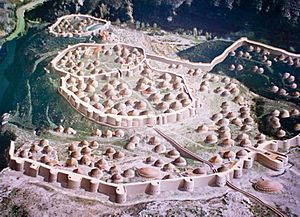
In Spain and Portugal, the Bell Beaker culture marks the late part of the local Copper Age. It also extends into the early Bronze Age. Some of the earliest Bell Beaker dates in Europe are from Portugal.
Corded Bell Beakers are usually found near the coast. They are in the western Pyrenees, the lower Ebro, and the northwest. A mixed style (C/ZM) was found mainly in burials. It spread westward along mountain ranges.
Most early Bell Beaker burials in Spain and Portugal are near coastal areas. Bell Beaker pottery is often found with local Copper Age items. It seems like a new addition to older burial sites.
Very early Bell Beaker dates were found at Castelo Velho de Freixo de Numão in northern Portugal. The site shows a first occupation around 3000 BC. After a short break, Bell Beaker pottery appeared. This second phase lasted until about 1800 BC. The pottery was mostly local Maritime Bell Beakers. One non-local piece of pottery was found. It was a classic European corded ware style. This type was rare in Spain and Portugal.
In 2016, a large circular earthwork was found near Valencia, Spain. It dates from the Bell Beaker period (2600-2200 BC). This complex of rings might have been used for rituals. Similar circular sites are known in Germany, Ireland, and the Netherlands. Stonehenge in England is also a similar site.
-
Bell Beaker from Ciempozuelos
-
Gold discs from western Asturias.
-
Dolmen de la Pastora, Spain.
Balearic Islands
Bell Beaker pottery was used on the Balearic Islands for about 1,200 years. This was from 2475 to 1300 BC. Some very old corded pottery in Mallorca suggests an even earlier settlement. Bell Beaker pottery has been found in Mallorca and Formentera. But it has not been seen in Menorca or Ibiza.
The presence of special pottery for making cheese confirms new food practices. Spindles found at sites show they knew how to make thread and textiles. The first signs of copper working in the Balearics were also linked to Bell Beakers.
Central Europe
In Central Europe, the Bell Beaker Culture began after 2500 BC. It existed alongside the Corded Ware culture. Their development was shaped by big river systems.
Bell Beaker settlements are hard to find. Experts used to think Bell Beaker people were "warlike invaders." Now, they believe these people added to local traditions. However, recent DNA evidence suggests a big replacement of earlier populations.
Bell Beaker pottery in Bohemia and Southern Germany was new. It had no links to local cultures. The Bell Beaker pottery of Southern Germany is not closely related to the Corded Ware. Settlements link the Southern German Bell Beaker culture to the Eastern Group. This group includes Moravia and the Hungarian Bell Beaker-Csepel group. In 2002, a large Bell Beaker cemetery was found in the Czech Republic.
Bell Beaker settlements in Germany and the East-Group show mixed farming. They also raised animals. Tools like millstones and spindle whorls show they lived in one place. Some child burials with rich items suggest a complex society.
Around 2300 BC, large circular enclosures were built in central Germany. These were important ritual sites. They were used until about 1900 BC. The main entrances of the Pömmelte enclosure faced sunrise and sunset. This shows it was used for ceremonies linked to the calendar. Pömmelte and Schönebeck were part of a sacred landscape. This landscape started with a Corded Ware sanctuary. The Pömmelte enclosure is almost identical to Stonehenge in England. Excavators believe they were built by the "same culture."
-
Bell Beaker from the Czech Republic
-
Copper dagger from Brandenburg, Germany.
-
House reconstruction, Csepel group, Hungary.
Ireland
Beakers arrived in Ireland around 2500 BC. They stopped being used around 1700 BC. In Ireland, beaker pottery was rarely buried with the dead. It was often found in homes. This is different from other parts of Europe. The Irish used food vessels for burials instead.
Large, communal passage tombs from the Stone Age were no longer built. But some, like Newgrange, were reused. People preferred single graves or small wedge tombs. Cremation was also common.
The arrival of the Bell Beaker culture in Ireland meant the end of the Stone Age culture. Smaller tombs were destroyed, and the great mound at Newgrange collapsed.
Many beakers are found in Ireland. The new way of making pottery shows that the makers were there. Five of the seven Bell Beaker groups from Europe also appeared in Ireland. However, many Bell Beaker features from Britain did not reach Ireland. Instead, Irish customs were influenced by older traditions.
The earliest copper mines in Ireland are at Ross Island. They started around 2500 BC. Copper from Ross Island was the only source in Ireland between 2500–2200 BC. It was also a major export to Britain. Traces of this copper are found in the Netherlands and Brittany. After 2200 BC, other mines opened.
Irish food vessels were adopted in northern Britain around 2200 BC. This was when beakers declined in Britain. The 'bronze halberd' was a weapon used in Ireland from 2400–2000 BC. It was a broad blade on a long handle. It gave greater reach than other weapons. Halberds were later adopted in other parts of Europe. This might show a change in how warfare was done.
Sun Symbols
Ireland has the most gold lunulae and stone wrist-guards in Europe. These items were not buried in graves. They are usually found alone.
Some gold lunulae have been found with pairs of gold discs. These items are linked to sun worship. One expert connects them to a "great solar cult." This cult stretched across Europe to Scandinavia. The plain part of the lunulae might show a "solar boat." This is like the gold boat on the Nebra sky disc. It is also like sun boats from the Nordic Bronze Age. The gold discs might represent "the day and night sun." This symbolizes the sun's movement.
Studies show that gold for Irish lunulae and the Nebra sky disc came from Cornwall. This links these items. Gold for discs from Spain also came from outside the area. It might have come from southern Britain.
-
Gold lunula from Westmeath, c. 2000 BC
Britain
Beakers arrived in Britain around 2500 BC. This was with migrations of people related to the Yamnaya or Corded Ware cultures. It led to a near total change in the British population. The Beaker culture declined around 2200–2100 BC. It was replaced by food vessels and burial urns. It finally stopped being used around 1700 BC. The first British beakers were like those from the Rhine. Later styles were more like those from Ireland. Most British beakers are found in burial sites.
Britain's only unique export then was likely tin. It was probably found in streams in Cornwall and Devon. It was traded as raw pebbles. Tin was used to turn copper into bronze from about 2200 BC. It was widely traded in Britain and Ireland.
The most famous site from this period is Stonehenge. Its Stone Age form was greatly expanded. Many burial mounds surround it. Many 'rich' burials are found nearby. These include the Amesbury Archer and the later Bush Barrow.
Silbury Hill was also built in the early Bell Beaker period. It might have been a burial mound. Experts say the building of Stonehenge and Silbury Hill grew after Beaker people arrived. More labor was used after Beaker people came to Britain. The effort to build Silbury Hill was much more than Stonehenge. Its dates match the appearance of Beaker burials. Beaker people also brought mummification and burial in log coffins to Britain.
Timothy Darvill suggested that Stonehenge was a solar calendar. It marked the spread of sun worship ideas across Northern Europe. He also suggested the Stonehenge trilithons might represent twin gods.
An important site is Ferriby in England. Europe's oldest sewn-plank boats were found there. They date from as early as 2030 BC. These are the oldest known sewn-plank boats outside of Egypt.
-
Gold lunula from Cornwall, c. 2400 BC.
-
Gold lunula, Wales, 2400-2000 BC.
-
Ferriby boat, c. 2000 BC, model and replica tools
Italian Peninsula
In Italy, the most affected areas were the Po Valley and Tuscany. Bell-shaped vases appeared as "foreign elements." They were mixed with the existing Remedello and Rinaldone cultures.
Graves with Beaker items have been found in the Brescia area. In central Italy, bell-shaped glasses were found in a tomb in Viterbo.
The Bell Beaker culture was followed by the Polada culture and Proto-Apennine culture.
Sardinia
Sardinia had contact with other communities since the Stone Age. From the late 3rd millennium BC, comb-impressed Beaker pottery was found. This shows ongoing connections with the western Mediterranean. Bell Beaker items were found in burials. They were also found with the Bronze Age Bonnanaro culture. Gold items appeared for the first time on the island.
The different styles of pottery show three phases for the Bell Beaker culture in Sardinia. These phases show two influences. One was "Franco-Iberian" (from France and Spain). The second was "Central European."
Sardinia likely helped bring the Beaker culture to Sicily.
-
Domus de Janas tomb, Sardinia
-
Beaker, necropolis of Anghelu Ruju, Sardinia
-
Tripod bowl, necropolis of Santu Pedru, Sardinia
-
Bell Beaker bowl from Monte d'Accoddi.
Sicily
The Beaker culture came to Sicily from Sardinia. It spread mainly in the north-west and south-west. In the north-west, it kept its cultural features. In the south-west, it mixed a lot with local cultures. Only one bell-shaped glass was found in eastern Sicily, in Syracuse.
In Denmark, large forests were cleared for farming. This happened during the Single Grave culture and Late Neolithic. Small signs of Bell Beaker influence appeared in pottery. Bell Beaker objects like wristguards also reached these northern areas. Settlements with Beakers appeared 200–300 years later. These sites are in northern Jutland.
Stone and Copper Trade
Northern Jutland had a lot of high-quality flint. This led to a big production of flint objects. The Danish Beaker period made long flint daggers. These were new and related to daggers in other Bell Beaker areas. The Bell Beaker culture likely spread from here to the rest of Denmark.
The spread of metalworking in Denmark is linked to Beakers. Early copper and gold items are found in northern Jutland. This suggests a link between Beakers and metalworking. Most early metal objects were influenced by Western European Beaker metalwork. Gold sheet ornaments and copper flat axes were common.
Connections with Other Beaker Areas
|
The Beaker group in northern Jutland was part of the Western European Beaker Culture. Western Jutland connected the Lower Rhine area to northern Jutland. The local fine pottery shows links to other Beaker regions. The introduction of metalworking shows that people moved across cultural borders.
Clusters of Bell Beaker presence appeared as "islands" in northern Europe. These were in Mecklenburg, Schleswig-Holstein, and southern Norway. The frequent finding of Beaker pottery in settlements suggests a shared social or cultural identity.
In 2023, a large circular enclosure was found near Tiel in the Netherlands. It dates from about 2000 BC. It was called the "Stonehenge of the Netherlands." It had earth banks and ditches. Its entrances lined up with the solstices and equinoxes. It was used as a solar calendar. A glass bead from Mesopotamia was found there. This shows long-distance trade existed.
Three gold lunulae have been found in Denmark from the Bell Beaker period. One was found in the Netherlands.
Burial Customs
In eastern Denmark, single graves were common. This continued the burial custom of the Scanian Battle-axe Culture. In northern Jutland, bodies were usually laid on their back. But sometimes, they were in a typical Bell Beaker crouched position. Cremations were also reported.
Social Changes
The start of flint dagger making around 2350 BC was a time of social change. Craft skills were passed down in families. People started wearing woven wool clothes. These were held with pins and buttons. This was different from earlier clothes made of leather. Houses in Late Neolithic Denmark were similar to those in other parts of Northern Europe.
End of the Bell Beaker Culture
The Bell Beaker culture mixed with local Late Neolithic cultures. For a while, this region was separate from central and eastern Denmark. Those areas were more linked to the early Únětice culture. Before 2000 BC, the typical Bell Beaker features were gone. The culture lasted for 200–300 years at most.
A similar mixing of cultures happened in Central Europe. This challenged old ideas that Bell Beakers were only for elite groups. Connections with the East Group Beakers of Únětice grew stronger. This led to new social changes and metalworking innovations. These changes marked the start of the Northern Bronze Age.
Images for kids
-
Ferriby boat, c. 2000 BC, model and replica tools
See also
 In Spanish: Cultura del vaso campaniforme para niños
In Spanish: Cultura del vaso campaniforme para niños
- Beaker (disambiguation)
- Amesbury Archer
- Prehistoric Britain
- Prehistoric Iberia
- Bronze Age Britain
- Cornish Bronze Age



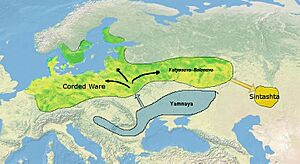
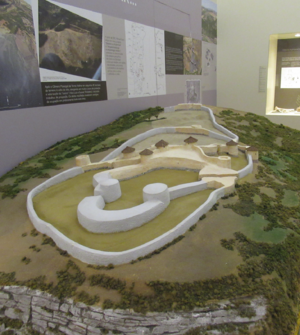
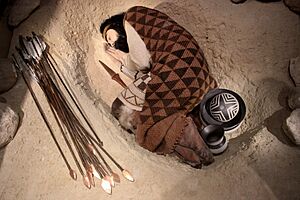
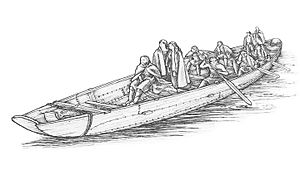
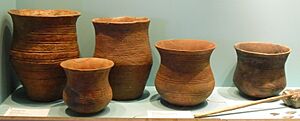
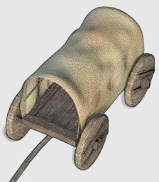

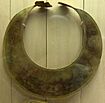

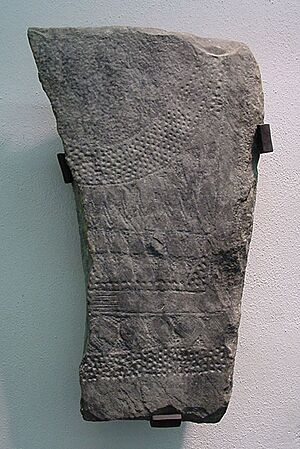
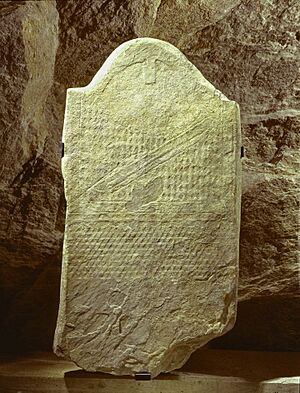
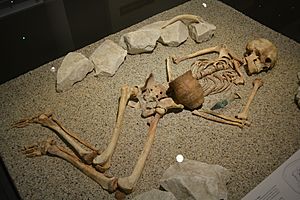
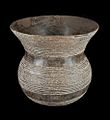



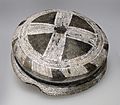
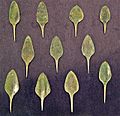



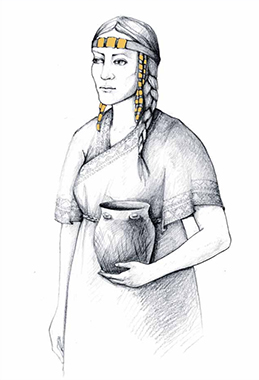

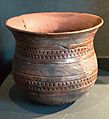
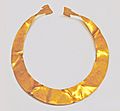


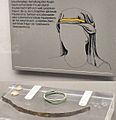





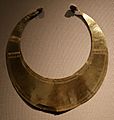


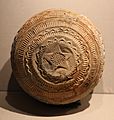
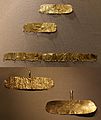

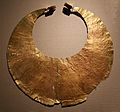
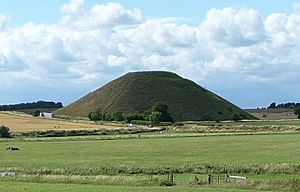
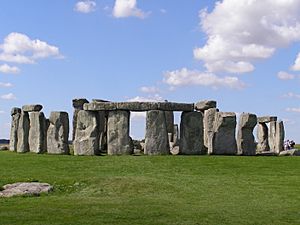
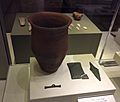
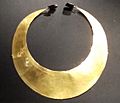
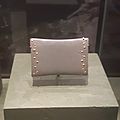
![Gold lunula, Wales, 2400-2000 BC.[119]](/images/thumb/5/59/Gold_lunula_from_Llanllyfni%2C_Wales%2C_2400-2000_BC_%282%29.jpg/120px-Gold_lunula_from_Llanllyfni%2C_Wales%2C_2400-2000_BC_%282%29.jpg)







